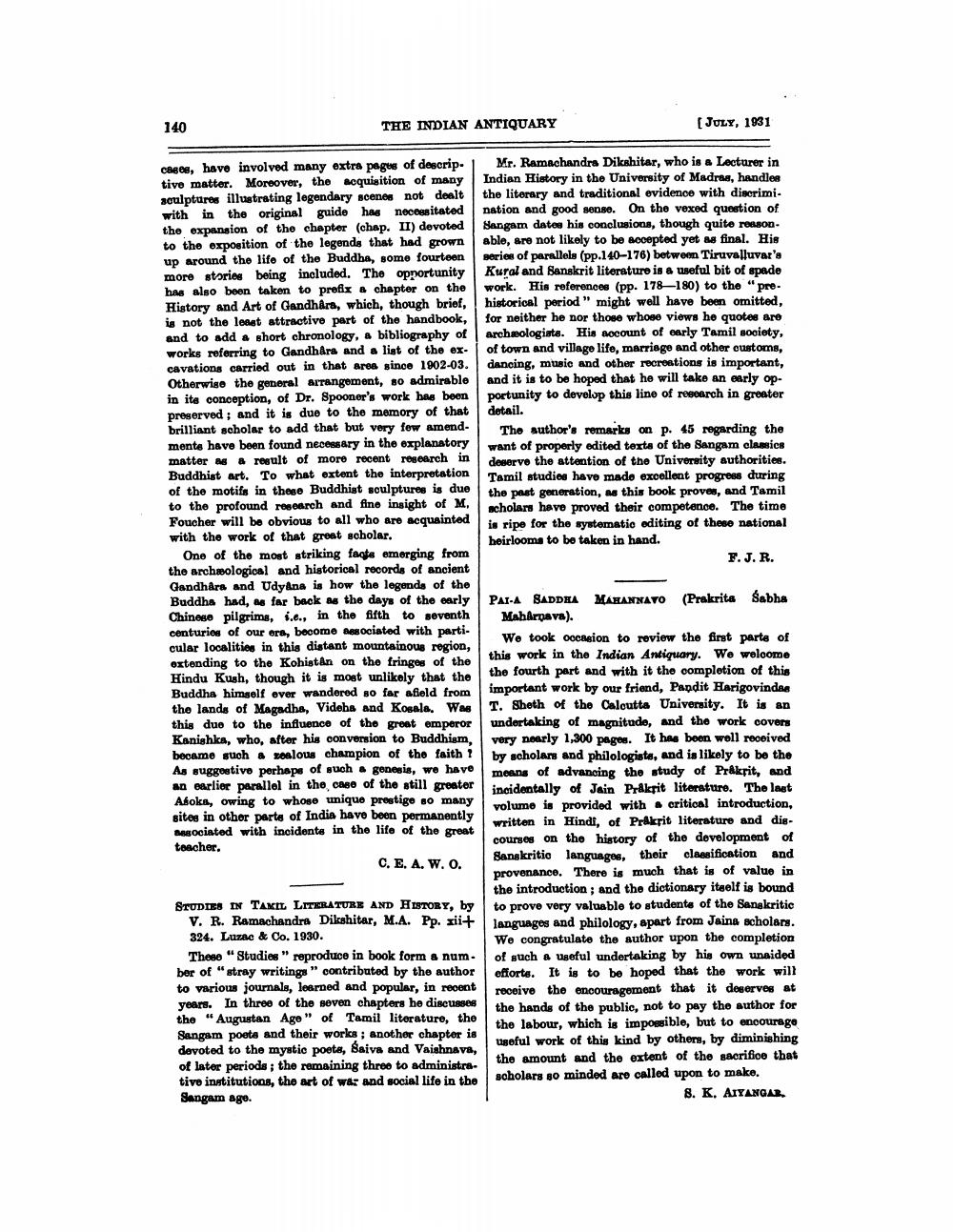________________
140
THE INDIAN ANTIQUARY
[JULY, 1931
CBO, have involved many extra pages of descrip-1 Mr. Ramachandra Dikshitar, who is a Lecturer in tive matter. Moreover, the acquisition of many Indian History in the University of Madras, handles sculptures illustrating legendary scenes not dealt the literary and traditional evidence with discrimi. with in the original guide has necessitated nation and good sense. On the vexed question of the expansion of the chapter (chap. II) devoted Sangam dates his conclusions, though quite reasonto the exposition of the legends that had grown able, are not likely to be accepted yet a final. His up around the life of the Buddha, some fourteen series of parallels (pp.140-176) between Tiruvalluvar's more stories being included. The opportunity Kural and Sanskrit literature is a useful bit of spade has also been taken to prefix & chapter on the work. His references (pp. 178-180) to the "preHistory and Art of Gandhara, which, though brief, historical period " might well have been omitted, is not the least attractive part of the handbook, for neither he nor those whose views he quotes are and to add a short chronology, a bibliography of archæologists. His account of early Tamil society, works referring to Gandhåra and a list of the ex. of town and village life, marriage and other customs, cavations carried out in that ares since 1902-03. dancing, music and other recreations is important, Otherwise the general arrangement, so admirable and it is to be hoped that he will take an early opin its conception, of Dr. Spooner's work has been portunity to develop this line of research in greater preserved ; and it is due to the memory of that detail. brilliant scholar to add that but very few amend- The author's remarks on p. 45 regarding the ments have been found necessary in the explanatory
want of properly edited texts of the Sangam classics matter As a result of more recent research in
deserve the attention of the University authorities. Buddhist art. To what extent the interpretation
Tamil studies have made excellent progress during of the motifs in these Buddhist sculptures is due
the past generation, as this book proves, and Tamil to the profound research and fine insight of M.
scholars have proved their competence. The time Foucher will be obvious to all who are acquainted
is ripe for the systematic editing of these national with the work of that great scholar.
heirlooms to be taken in hand. One of the most striking facts emerging from
F.J.R. the archæological and historical records of ancient Gandhåra and Udyana is how the legends of the Buddha had, as far back as the days of the early PAIA SADDHA MAHANNAVO (Prakrita Sabha Chinese pilgrima, i.e., in the fifth to seventh
MahArpava). centuries of our era, become associated with parti
We took cular localities in this distant mountainous region,
casion to review the first parts of extending to the Kohistan on the fringes of the
this work in the Indian Antiquary. We welcome Hindu Kush, though it is most unlikely that the
the fourth part and with it the completion of this Buddha himself over wandered so far afield from
important work by our friend, Pandit Harigovinden the lands of Magadha, Videba and Kosala. Was T. Shoth of the Caloutta University. It is an this due to the influence of the great emperor undertaking of magnitude, and the work covers Kanishka, who, after his conversion to Buddhism, very nearly 1,300 pages. It has been well received became such a realous champion of the faith? |
by scholars and philologiste, and is likely to be the As suggestive perhape of such. genesis, we have
means of advancing the study of Prakrit, and an earlier parallel in the case of the still greater
incidentally of Jain Prakrit literature. The last Aboka, owing to whose unique prestige so many
volume is provided with critical introduction, sites in other parts of India have been permanently Mesociated with incidents in the life of the great
written in Hindi, of Prakrit literature and disteacher.
courses on the history of the development of C.E.A.W.O.
Sanskritio languages, their classification and provenance. There is much that is of value in
the introduction, and the dictionary itself is bound STUDIES IN TAMIL LITERATURE AND HISTORY, by to prove very valuable to students of the Sanskritic
V. R. Ramachandra Dikshitar, M.A. Pp. xii+ languages and philology, apart from Jaina scholars. 324. Luzac & Co. 1930.
We congratulate the author upon the completion These "Studies" reproduce in book form & num. of such a useful undertaking by his own unaided ber of "stray writings" contributed by the author efforts. It is to be hoped that the work will to various journals, learned and popular, in recent
receive the encouragement that it deserves at years. In three of the seven chapters he discusses
the hands of the public, not to pay the author for the "Augustan Age" of Tamil literature, the
the labour, which is impossible, but to encourage Sangam poeta and their works; another chapter is
useful work of this kind by others, by diminishing devoted to the mystic poeta, Baiva and Vaishnava, of later periods: the remaining three to administra
the amount and the extent of the sacrifioe that tive institutions, the art of war and social life in the
scholars 80 minded are called upon to make. Sangam age.
8. K. AITANGAR




